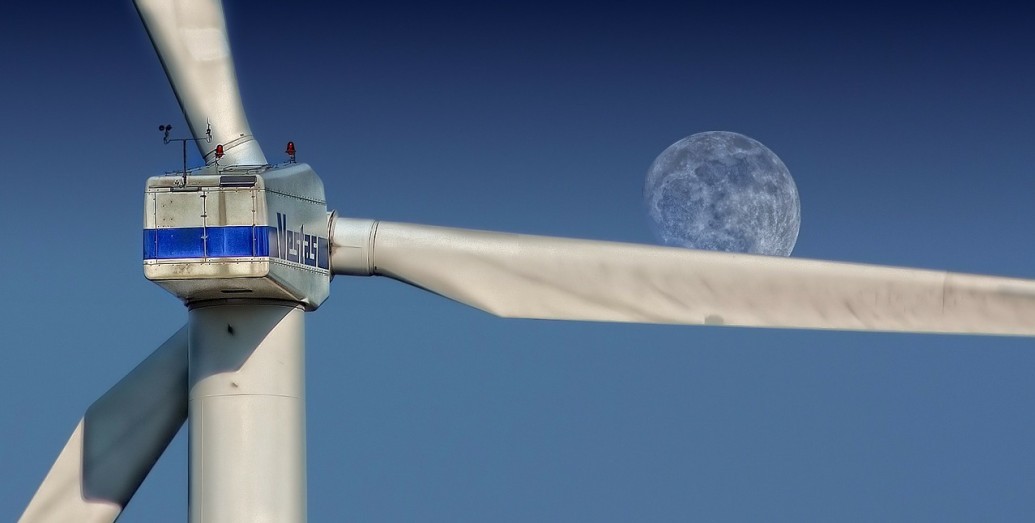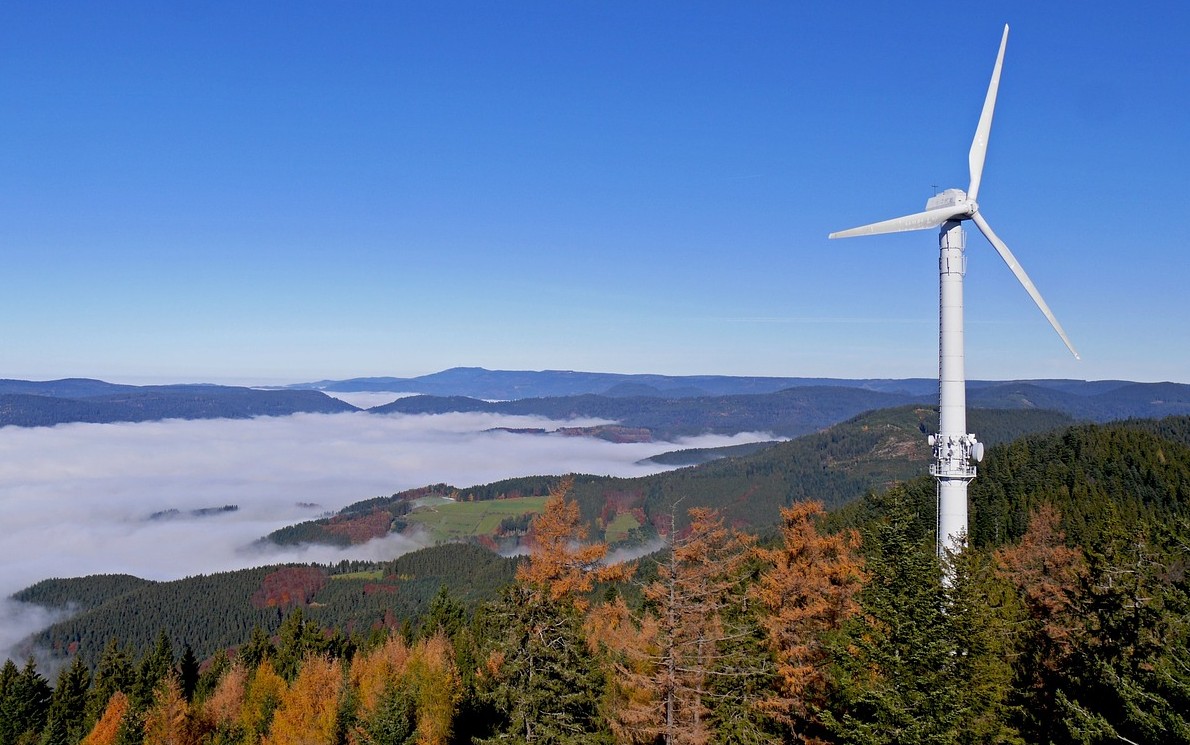
[:sk]
Veterná energia alebo energia získaná prostredníctvom využívania sily vetra patrí medzi najstaršie využívané obnoviteľné zdroje elektrickej energie. Nakoľko vietor sa nachádzal skoro všade, bol človekom využívaný už od nepamäti. Veterná energia patrí medzi tzv. čistú energiu nakoľko neznečisťuje ovzdušie, neprodukuje žiadne odpady a tým pádom nemá negatívny dopad na život človeka.
Sila vetra, ktorá je základom veternej energie človek využíval už odpradávna. Či už to bolo na pohon plavidiel, alebo na pohon veterných mlynov, či pomoc pri zavlažovaní. Postupom času sa sila vetra začala využívať aj na výrobu elektrickej energie. Avšak využívanie iných druhov výroby elektrickej energie (uhoľné, plynové a jadrové elektrárne a pod.) zatlačilo do úzadia získavanie elektrickej energie prostredníctvom využívania sily vetra. V súčasnosti sa však k takémuto druhu výroby elektrickej energie zasa vraciame a elektrická energia vyrobená prostredníctvom využívania sily vetra sa stáva pevnou súčasťou tzv. energetického mixu.
Napriek tomu, že v súčasnej dobe dochádza k opätovnému nárastu využívanie výroby elektrickej energie prostredníctvom využívania sily vetra, mnohí odborníci poukazujú na to, že potenciál výroby elektrickej energie týmto spôsobom nie je využívaný dostatočne a mohol by sa vo väčšej miere podieľať na celkovej výrobe elektrickej energie. Avšak na druhej strane je poukazované hlavne na nestabilitu dodávok elektrickej energie z tohto druhu výroby čoho následkom je nápor na jednotlivé prenosové sústavy a neprirodzený zásah do rázu krajiny.

V rámci Európskej únie sa veterná energia podieľa na celkovej výrobe elektrickej energie zhruba 5%. Najviac nainštalovaných veterných parkov v rámci Európskej únie je v Španielsku, Nemecku, Taliansku a Rakúsku. Podľa cieľov Európskej únie by sa mal podiel veternej energie na celkovej výroby elektrickej energie zvýšiť do roku 2020 na 10%.
Na Slovensku veterná energia predstavuje iba zlomok z celkovo vyrobenej elektrickej energie. Celkový inštalovaný výkon je zhruba 5 MW, čo predstavuje spotrebu zhruba 3 tisíc domácnosti. Dôvody nedostatočného využívania veternej energie na Slovensku sú nasledovné:
– nedostatok vhodných lokalít na výstavbu veterných parkov,
– časť vhodných lokalít sa nachádza v chránených územiach,
– Slovenská elektrizačná a prenosová sústava nevydáva povolenia na pripojenie nových veterných parkov do prenosovej sústavy,
– potreba získania množstva povolení.
Podielom veternej energie na celkovej výrobe elektrickej energie sa Slovensko nachádza na samom chvoste krajín Európskej únie.
[:en]Wind energy or energy obtained through the use of wind power is one of the oldest used renewable electricity. Since the wind was located almost everywhere, it has been used by man since time immemorial. Wind energy is among the so-called. clean energy since it does not pollute the air, produces no waste and therefore does not have a negative impact on a person’s life.
Wind power, which is the basis of wind energy use by man since ancient times. Whether it was the propulsion of vessels or to drive windmills, or help with irrigation. Over time, the wind began to use force and to generate electricity. However, the use of other types of power generation (coal, gas and nuclear power plants, etc.) Overshadowed the acquisition of electricity through the use of wind power. At present, however, to this type of electricity generation retrogress and electricity generated through the use of wind power it is becoming an integral part of the so-called. energy mix.
Despite the fact that currently there is a renewed increase the use of electricity through the use of wind power, many experts point out that the potential for electricity generation in this way has been underutilized and could be a greater proportion of total electricity generation . But on the other hand, it is mainly remitted to the instability of electricity supply of this type of production resulting in the strain on the individual transmission and unnatural intervention in the landscape.
Within the European Union is involved in wind energy in total electricity generation around 5%. Most installed wind parks in the European Union in Spain, Germany, Italy and Austria. According to the objectives of the European Union should be the share of wind energy in total electricity generation in 2020 to 10%.
In Slovakia, wind power represents only a fraction of the total electricity produced. The total installed capacity of about 5 MW, representing the consumption of about 3,000 households. Because of insufficient wind energy in Slovakia are as follows:
– The lack of suitable sites for the construction of wind parks,
– Part of suitable sites located in protected areas
– Slovak Electricity Transmission System and does not issue permission to connect new wind farms to the transmission system,
– The need to obtain authorization amount.
The share of wind energy in total electricity generation Slovakia is at the very tail of the European Union countries.[:de]Lorem ipsum dolor sit amet, consectetuer adipiscing elit, sed diam nonummy nibh euismod tincidunt ut laoreet dolore magna aliquam erat volutpat. Ut wisi enim ad minim veniam, quis nostrud exerci tation ullamcorper suscipit lobortis nisl ut aliquip ex ea commodo consequat.
Duis autem vel eum iriure dolor in hendrerit in vulputate velit esse molestie consequat, vel illum dolore eu feugiat nulla facilisis at vero eros et accumsan et iusto odio dignissim qui blandit praesent luptatum zzril delenit augue duis dolore te feugait nulla facilisi. Nam liber tempor cum soluta nobis eleifend option congue nihil imperdiet doming id quod mazim placerat facer possim assum. Typi non habent claritatem insitam; est usus legentis in iis qui facit eorum claritatem. Investigationes demonstraverunt lectores legere me lius quod ii legunt saepius. Claritas est etiam processus dynamicus, qui sequitur mutationem consuetudium lectorum.
Mirum est notare quam littera gothica, quam nunc putamus parum claram, anteposuerit litterarum formas humanitatis per seacula quarta decima et quinta decima. Eodem modo typi, qui nunc nobis videntur parum clari, fiant sollemnes in futurum.[:]